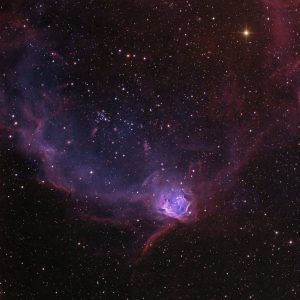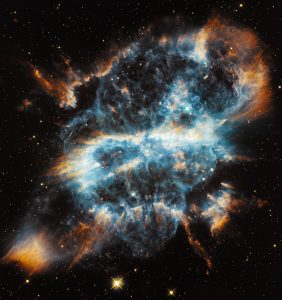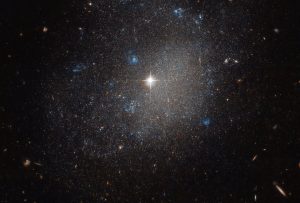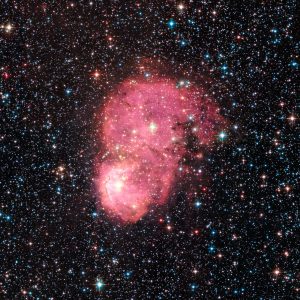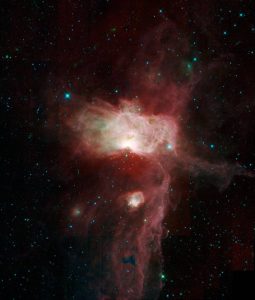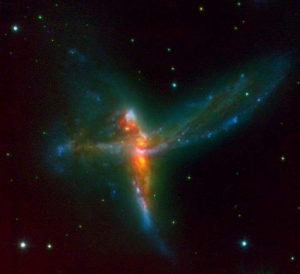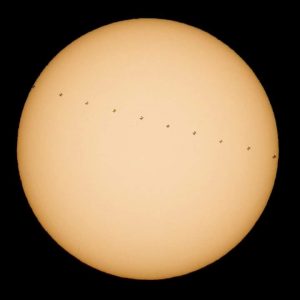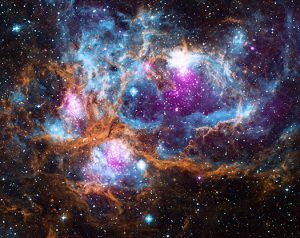Immagini
Il Risveglio della Forza di una Stella
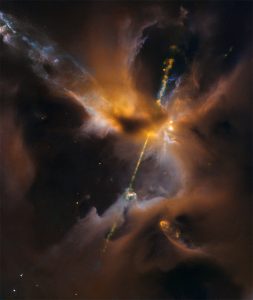
Nel centro di questa fantastica immagine, parzialmente oscurata da un mantello di polvere, una giovanissima stella spara getti gemelli nello spazio, un’azione che dimostra la potenza delle forze in azione nell’Universo. Questa “spada laser” celeste si trova all’interno della nostra galassia, la Via Lattea. Più precisamente, in una regione turbolenta conosciuta come Complesso Nebuloso Molecolare Orion B, a poco più di 1350 anni luce di distanza nella costellazione di Orione.
Le Ali della Lucertola Volante
Ai confini della Piccola Nube di Magellano risplende un giovane ammasso stellare dell’età di 5 milioni di anni, NGC 602. Circondato dal gas e dalle polveri in cui si è formato, il gruppo di stelle bambine può essere osservato proprio sotto il centro in questa splendida immagine. Continua a leggere
Gemme Preziose nel Pozzo dei Desideri
Questa straordinaria immagine del brillante ammasso stellare NGC 3532, ripresa dal telescopio dell’MPG/ESO a La Silla ricorda un insieme di gemme preziose o il bagliore colorato di luci natalizie. Alcune stelle risplendono ancora di un caldo tono bluastro, ma molte tra le più massicce sono diventate giganti rosse e brillano di una vivace tonalità arancio. Continua a leggere
Un Nastro Festoso
L’intricata struttura della splendida nebulosa planetaria NGC 5189, immortalata dal telescopio Hubble, si presenta come un gigantesco nastro festoso dai colori vivaci. Le nebulose planetarie rappresentano una breve fase finale nella vita di una stella come il Sole. Mentre consuma l’ultimo combustibile a disposizione nel nucleo, la stella espelle gran parte delle sue regioni esterne, che poi si scaldano e brillano, formando complesse strutture. La struttura visibile in NGC 5189 è particolarmente spettacolare. Continua a leggere
Puntinismo stellare
In una limpida notte dell’aprile 1789 l’astronomo William Herschel, mentre proseguiva la sua inarrestabile esplorazione del cielo notturno, individuò un nuovo oggetto cosmico ed ebbe occasione di festeggiare! Incrementando la sua lista straordinaria di scoperte ancora una volta, l’astronomo osservò questa brillante galassia a spirale, chiamata NGC 4707, nella costellazione dei Cani da Caccia. NGC 4707 si trova a circa 22 milioni di anni luce dalla Terra. Continua a leggere
Luminarie accese nella Piccola Nube
Questa sfavillante nebulosa di un bel rosa intenso, immortalata con grande dettaglio dal telescopio Hubble e chiamata NGC 248, si trova nella Piccola Nube di Magellano, a circa 200.000 anni luce di distanza. Continua a leggere
Decorazioni Celesti
Questa immagine mozzafiato ripresa dal telescopio Wide-field Infrared Survey Explorer (WISE) immortala tre famose nebulose che fanno parte del gigantesco Complesso Nebuloso Molecolare di Orione (Orion Molecular Cloud): la nebulosa Fiamma (Flame Nebula), la nebulosa Testa di Cavallo (Horsehead Nebula) e NGC 2023. Continua a leggere
Una Fatina Cosmica
Utilizzando il Very Large Telescope dell’ESO, un team internazionale di astronomi ha individuato uno splendido, raro caso di triplice fusione di galassie. Questo sistema, che gli astronomi hanno soprannominato L’Uccello (“The Bird”), anche se potrebbe assomigliare ad una fatina Trilly cosmica, si compone di due galassie a spirale massicce e una terza galassia irregolare. Continua a leggere
Transito della Stazione Spaziale Internazionale sul disco solare
Questa straordinaria immagine composita, realizzata unendo 10 fotogrammi, mostra la ISS (che ora ospita 6 astronauti) in silhouette mentre transita davanti al Sole ad una velocità di circa 8 chilometri al secondo. È stata ripresa da Newbury Park, California, il 17 dicembre 2016. Continua a leggere
Paese delle Meraviglie Cosmico
Sebbene nello spazio non esistano stagioni, questo straordinario panorama cosmico ricorda un freddo paesaggio invernale dall’atmosfera magica. In questa fiabesca regione, chiamata NGC 6357, la radiazione delle calde, giovani stelle sta energizzando il gas più freddo nella nube circostante, facendolo brillare. Continua a leggere
